By Leen Randell
Updated: Jul 10, 2024
10 Best Herbal Decoctions For Endometriosis
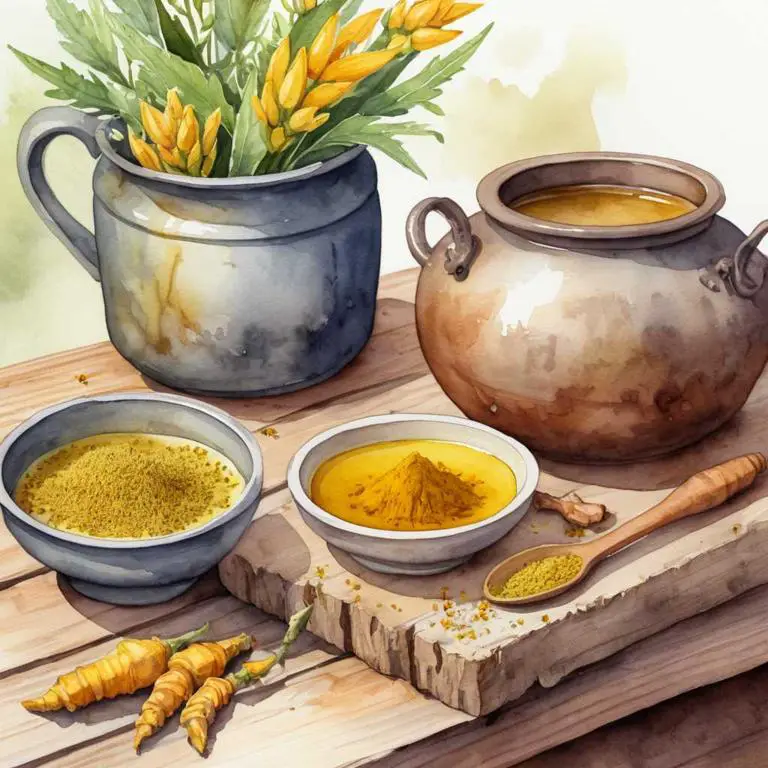
Herbal decoctions for endometriosis are concentrated liquid extracts made from a combination of herbs, which can provide relief from symptoms such as pain, inflammation, and hormonal imbalances associated with the condition.
These herbal decoctions help by reducing inflammation, regulating hormones, and improving digestion, which in turn alleviates symptoms like cramps, bloating, and heavy bleeding. For example, dandelion root and turmeric have anti-inflammatory properties that can reduce pain and swelling, while chasteberry has been shown to balance hormone levels and alleviate hot flashes.
By incorporating herbal decoctions into their daily routine, individuals with endometriosis can experience improved overall health, reduced symptoms, and a better quality of life.
The following article describes in detail the most important decoctions for endometriosis, including medicinal properties, parts of herbs to use, and recipes for preparations.
- 1. Curcuma longa
- 2. Zingiber officinale
- 3. Viburnum opulus
- 4. Taraxacum officinale
- 5. Trifolium pratense
- 6. Matricaria chamomilla
- 7. Passiflora incarnata
- 8. Mentha x piperita
- 9. Actaea racemosa
- 10. Verbena hastata
- What is the best combination of herbal decoctions to use for endometriosis?
- What ailments similar to endometriosis are treated with herbal decoctions?
1. Curcuma longa
Turmeric decoctions helps with endometriosis because it contains curcumin, a potent anti-inflammatory compound that reduces inflammation in the body.
Endometriosis is characterized by chronic inflammation and scarring, which turmeric's anti-inflammatory properties can help alleviate. Additionally, turmeric has been shown to improve hormonal balance, which is often disrupted in individuals with endometriosis.
By reducing inflammation and promoting hormonal balance, turmeric decoctions may provide relief from symptoms such as pelvic pain, heavy bleeding, and cramping associated with the condition.
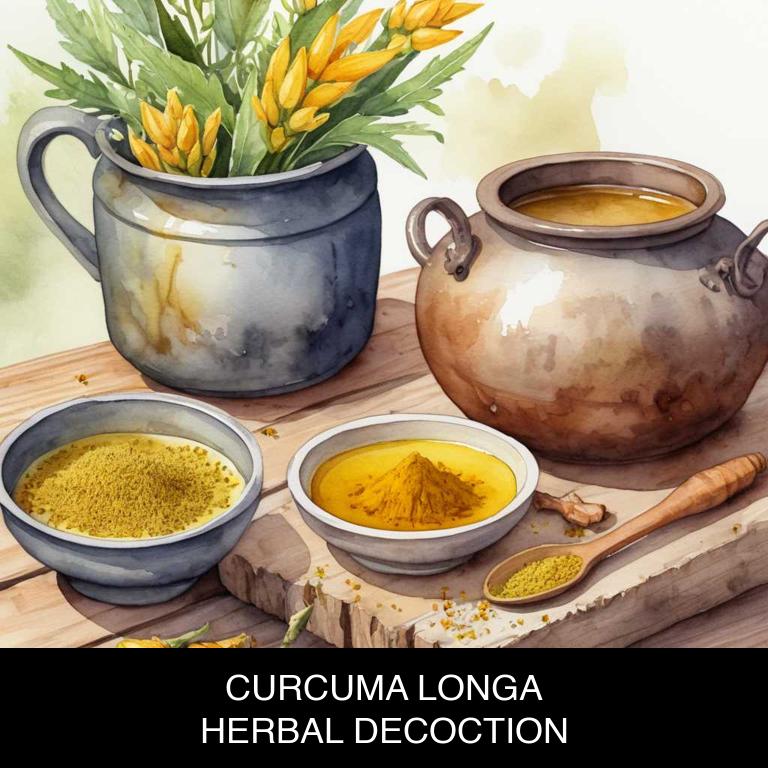
Medicinal Constituents
The list below shows the primary medicinal constituents in Curcuma longa decoctions that help with endometriosis.
- Curcuminoids: They have potent anti-inflammatory and antioxidant properties that can help reduce inflammation and oxidative stress associated with endometriosis.
- Catechins: They have been shown to inhibit the growth of endometrial cells and reduce the production of pro-inflammatory cytokines, which can contribute to the development and progression of endometriosis.
- Demethoxycurcumin: It has been found to have anti-proliferative effects on endometrial cells, reducing cell growth and proliferation, and may also have anti-inflammatory properties that can help alleviate symptoms of endometriosis.
Parts Used
The list below shows the primary parts of turmeric used to make decoctions for endometriosis.
- Rhyzomes: Curcuma longa rhyzomes contain curcumin, a compound that has anti-inflammatory and antioxidant properties, which can help alleviate endometriosis symptoms.
- Roots: Turmeric root decoctions are used to reduce inflammation, pain, and discomfort associated with endometriosis, possibly due to its high curcumin content.
- Leaves: Turmeric leaves are also used in decoctions for their anti-inflammatory and antioxidant properties, which can help in reducing inflammation and promoting overall well-being in individuals with endometriosis.
Quick Recipe
The following recipe gives a procedure to make a basic turmeric for endometriosis.
- Harvest 5-10 fresh turmeric rhizomes for making decoctions which will be used for medicinal purposes.
- Dry the turmeric rhizomes in a warm place for 7-10 days or by air drying.
- Grind 1-2 dried turmeric rhizomes into fine powder using a spice grinder or mortar and pestle.
- Steep 1 teaspoon of turmeric powder in 1 cup of boiling water for 5-7 minutes.
- Strain the decoction through a cheesecloth or fine mesh to remove the solids before serving.
2. Zingiber officinale
Ginger decoctions helps with endometriosis because of its potent anti-inflammatory and antioxidant properties.
The active compounds in ginger, such as gingerols and shogaols, have been shown to reduce inflammation in the pelvic area, alleviating symptoms like cramping, bloating, and pain associated with endometriosis. Additionally, ginger's natural uterine relaxant effects can help regulate menstrual cycles and ease discomfort during menses.
By reducing inflammation and promoting relaxation, herbal ginger decoctions provide a natural and effective way to manage the debilitating symptoms of endometriosis.

Medicinal Constituents
The list below shows the primary medicinal constituents in Zingiber officinale decoctions that help with endometriosis.
- Curcumin: This polyphenolic compound has anti-inflammatory and antioxidant properties, which may help reduce inflammation and oxidative stress associated with endometriosis.
- 6-gingerol: A phenolic compound with anti-inflammatory and pain-relieving properties, 6-Gingerol may help alleviate pain and discomfort associated with endometriosis.
- Zingiberene: A sesquiterpene with anti-inflammatory and antioxidant properties, Zingiberene may help reduce inflammation and oxidative stress, potentially alleviating symptoms of endometriosis.
Parts Used
The list below shows the primary parts of ginger used to make decoctions for endometriosis.
- Rhyzomes: The rhyzomes are used due to their high concentration of bioactive compounds such as gingerols and shogaols, which have anti-inflammatory properties that may help alleviate endometriosis symptoms.
- Roots: The roots of Zingiber officinale are used for decoctions related to endometriosis because they contain compounds that may help reduce inflammation and modulate hormonal imbalances associated with the condition.
- Buds: The buds of Zingiber officinale are used due to their potential anti-inflammatory and antioxidant properties, which may help mitigate the symptoms and progression of endometriosis.
Quick Recipe
The following recipe gives a procedure to make a basic ginger for endometriosis.
- Harvest 1-2 grams of fresh zingiber officinale rhizomes and wash them thoroughly under cold running water.
- Chop the rhizomes into small pieces and combine them with 200 milliliters of boiling water in a saucepan.
- Reduce the heat to a simmer and let the mixture steep for 5-7 minutes to allow the flavors to infuse.
- Strain the decoction through a cheesecloth or a fine-mesh sieve into a clean container to remove the solids.
- Discard the solids and store the decoction in the refrigerator for up to 24 hours before consuming.
3. Viburnum opulus
Guelder rose decoctions helps with endometriosis because of its rich concentration of flavonoids, which have anti-inflammatory properties that alleviate pain and discomfort associated with the condition.
The decoction's antispasmodic effects also help to relax uterine muscles, reducing cramping and spasms common in endometriosis sufferers.
Additionally, guelder rose's antioxidant and estrogen-balancing properties may help to reduce inflammation and adhesion formation, promoting a healthier uterine environment and alleviating symptoms of endometriosis.
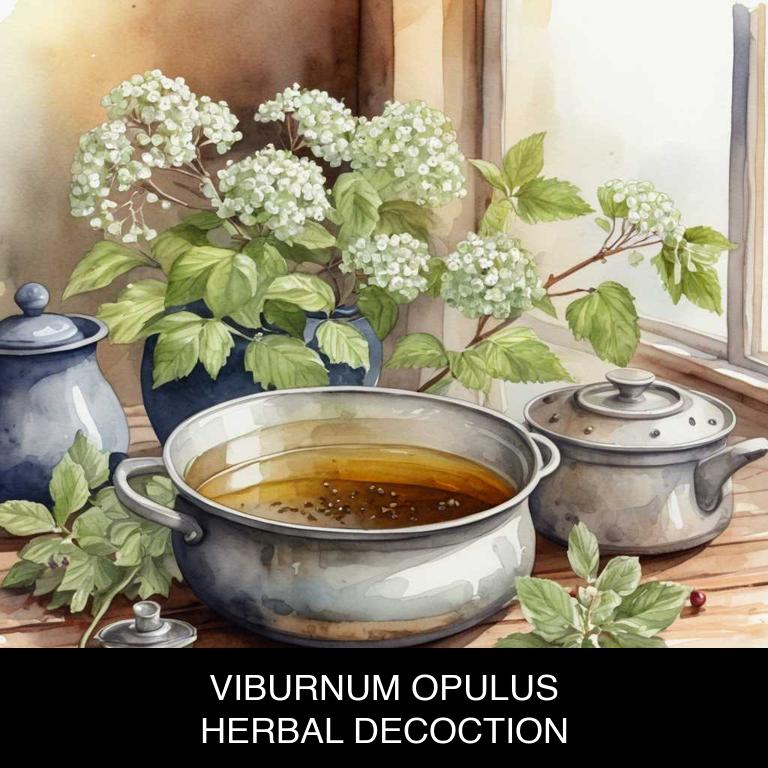
Medicinal Constituents
The list below shows the primary medicinal constituents in Viburnum opulus decoctions that help with endometriosis.
- Viburnin: A glycoside and a flavonoid compound, viburnin has anti-inflammatory and antioxidant properties, which may help reduce inflammation and oxidative stress associated with endometriosis.
- Iridoid glycosides: These compounds have been shown to have anti-inflammatory, antioxidant, and estrogen-modulating effects, which could help alleviate symptoms of endometriosis by reducing inflammation, preventing cell growth, and regulating hormonal imbalances.
- Phenolic acids: As potent antioxidants, phenolic acids may help protect against oxidative stress and inflammation in endometriosis, potentially reducing pain, inflammation, and scar tissue formation.
Parts Used
The list below shows the primary parts of guelder rose used to make decoctions for endometriosis.
- Roots: Used for their anti-inflammatory and antispasmodic properties to help alleviate endometriosis symptoms.
- Leaves: Utilized for their estrogen-regulating and anti-inflammatory effects to help manage endometriosis symptoms.
- Fruits: Employed for their anti-inflammatory and antioxidant properties to reduce pain and inflammation associated with endometriosis.
Quick Recipe
The following recipe gives a procedure to make a basic guelder rose for endometriosis.
- Harvest 20-30 grams of dried or fresh leaves and twigs of viburnum opulus in the fall season.
- Crush the harvested material into a fine powder using a mortar and pestle for 10 minutes.
- Combine the crushed material with 1 liter of boiling water in a large pot and let it simmer for 10-15 minutes.
- Strain the decoction through a cheesecloth or a fine-mesh sieve into a clean container for 5 minutes.
- Store the cooled decoction in a glass container in the refrigerator for up to 3 days.
4. Taraxacum officinale
Dandelion decoctions helps with endometriosis because it has been traditionally used to reduce inflammation, alleviate pain, and regulate menstrual cycles.
The plant's antioxidants and flavonoids help to combat oxidative stress and improve liver function, which can contribute to hormonal imbalance and chronic inflammation associated with endometriosis. Additionally, dandelion's diuretic properties may help to relieve symptoms such as bloating and cramping by reducing fluid retention.
By incorporating dandelion decoctions into one's herbal routine, individuals with endometriosis may experience a decrease in severity of symptoms and an improvement in overall health.

Medicinal Constituents
The list below shows the primary medicinal constituents in Taraxacum officinale decoctions that help with endometriosis.
- Flavonoids: These plant-based compounds may help alleviate endometriosis symptoms by reducing inflammation and oxidative stress, which are often associated with the condition.
- Phenolic acids: These antioxidants may help mitigate endometrial cell growth and proliferation, as well as reduce inflammation and oxidative damage in the body.
- Taraxasterol: This compound may possess anti-inflammatory and anti-proliferative properties, which could help alleviate symptoms and slow the progression of endometriosis.
Parts Used
The list below shows the primary parts of dandelion used to make decoctions for endometriosis.
- Leaves: The leaves are used due to their high content of flavonoids and other bioactive compounds that may help reduce inflammation and alleviate symptoms associated with endometriosis.
- Roots: The roots are used for their potential to regulate hormones and reduce inflammation, which may help alleviate symptoms of endometriosis.
- Flowers: The flowers are used for their possible anti-inflammatory and antioxidant properties, which may help reduce inflammation and alleviate symptoms associated with endometriosis.
Quick Recipe
The following recipe gives a procedure to make a basic dandelion for endometriosis.
- Gather 1/2 cup of fresh taraxacum officinale leaves and stems or 2 tablespoons of dried material for decoction.
- Combine the taraxacum officinale material with 2 cups of water in a saucepan and bring to a boil.
- Reduce heat and simmer the mixture for 10-15 minutes or 2 hours for dried material.
- Strain the decoction through a cheesecloth or fine mesh sieve into a clean container.
- Store the taraxacum officinale decoction in the refrigerator for up to 3 days or freeze for later use.
5. Trifolium pratense
Red clover decoctions helps with endometriosis because of its rich phytoestrogenic properties.
The isoflavones present in red clover mimic estrogen, binding to estrogen receptors and reducing inflammation, a common symptom of endometriosis. This natural anti-inflammatory effect can help alleviate pelvic pain, heavy bleeding, and other discomforts associated with the condition.
Additionally, red clover's ability to regulate hormone levels may also help reduce symptoms such as mood swings and bloating commonly experienced by women with endometriosis.
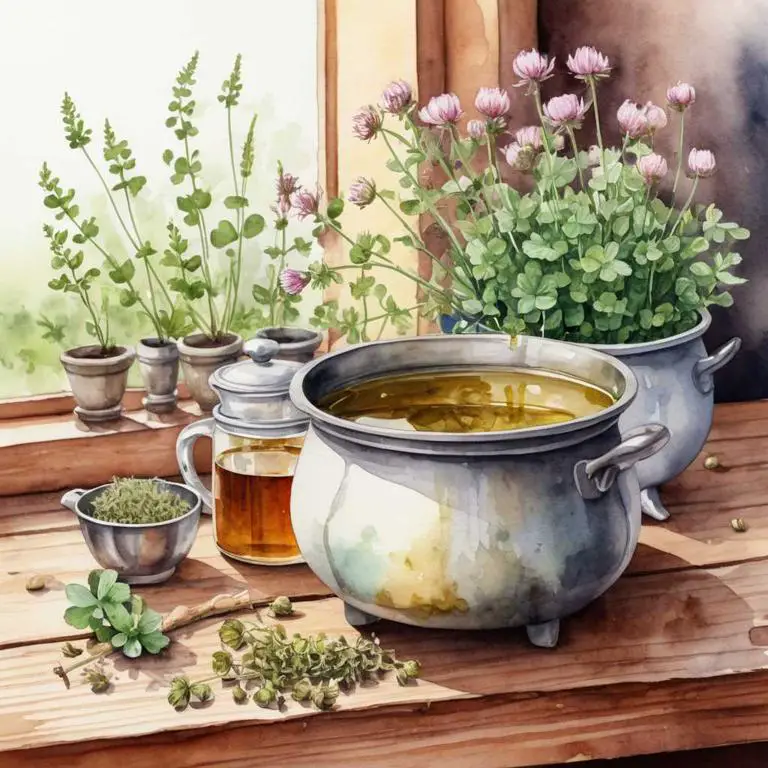
Medicinal Constituents
The list below shows the primary medicinal constituents in Trifolium pratense decoctions that help with endometriosis.
- Isoflavones: They help with endometriosis by inhibiting the growth of endometrial cells, reducing inflammation, and modulating estrogen levels to alleviate symptoms.
- Phenolic acids: They help by exhibiting antioxidant and anti-inflammatory properties, reducing oxidative stress, and suppressing the production of pro-inflammatory mediators that contribute to endometriosis.
- Coumarins: They help by inducing apoptosis (cell death) in endometrial cells, reducing their growth and proliferation, and also exhibiting anti-inflammatory and antioxidant properties to alleviate endometriosis symptoms.
Parts Used
The list below shows the primary parts of red clover used to make decoctions for endometriosis.
- Leaves: Used due to their high estrogenic content, which may help alleviate symptoms of endometriosis.
- Roots: Employed for their potential anti-inflammatory and antioxidant properties, which can aid in reducing endometriosis symptoms.
- Flowers: Utilized for their isoflavone content, which may help balance hormone levels and alleviate endometriosis symptoms.
Quick Recipe
The following recipe gives a procedure to make a basic red clover for endometriosis.
- Harvest 25 grams of dried red clover flowers in the morning after the dew has evaporated.
- Crush the dried flowers using a mortar and pestle to release their active compounds.
- Combine the crushed flowers with 500 milliliters of boiling water in a heat-resistant container.
- Steep the mixture for 5 to 10 minutes to allow the flavors and nutrients to infuse.
- Strain the decoction through a cheesecloth or a fine-mesh sieve into a clean container.
6. Matricaria chamomilla
Chamomile decoctions helps with endometriosis because it has anti-inflammatory properties that soothe the uterine lining, reducing inflammation and pain associated with the condition.
The herbal remedy also relaxes the muscles in the pelvic area, alleviating cramps and spasms caused by hormonal fluctuations.
Additionally, chamomile's calming effects can help to reduce stress and anxiety, which are common comorbidities of endometriosis, promoting a sense of overall well-being and balance.

Medicinal Constituents
The list below shows the primary medicinal constituents in Matricaria chamomilla decoctions that help with endometriosis.
- Apigenin: A flavonoid that acts as an anti-inflammatory agent, potentially reducing inflammation and pain associated with endometriosis.
- Α-bisabolol: A sesquiterpene alcohol with anti-inflammatory and antioxidant properties, which may help alleviate symptoms of endometriosis such as pain and inflammation.
- Apin: A flavonoid glycoside that has been shown to have anti-inflammatory and antioxidant effects, which could help mitigate the symptoms of endometriosis.
Parts Used
The list below shows the primary parts of chamomile used to make decoctions for endometriosis.
- Flowers: The flowers are the most commonly used part of Matricaria chamomilla due to their high concentration of apigenin and bisabolol, which have anti-inflammatory and soothing properties that can help alleviate endometriosis symptoms.
- Leaves: The leaves of Matricaria chamomilla contain flavonoids and terpenoids that have anti-inflammatory and antioxidant properties, which can help reduce inflammation and discomfort associated with endometriosis.
- Seeds: The seeds of Matricaria chamomilla are used to support hormonal balance and reduce inflammation, which can help alleviate endometriosis symptoms and promote overall reproductive health.
Quick Recipe
The following recipe gives a procedure to make a basic chamomile for endometriosis.
- Harvest 250g of dried matricaria chamomilla flowers from a trusted source and store them in an airtight container.
- Steep 10g of the dried flowers in 250ml of boiling water for 5 to 7 minutes.
- Strain the liquid through a fine-mesh sieve into a clean container to remove the solids.
- Discard the solids and let the decoction cool to room temperature for at least 30 minutes.
- Store the cooled decoction in the refrigerator for up to 24 hours before consumption.
7. Passiflora incarnata
Maypop decoctions helps with endometriosis because they have anti-inflammatory properties that can reduce inflammation in the pelvic area, which is a common symptom of the condition.
The flavonoids and saponins present in maypop also have been shown to have estrogen-balancing effects, which can help alleviate symptoms such as heavy bleeding and painful periods associated with hormonal imbalances.
Additionally, the antioxidants and flavonoids in maypop decoctions may help reduce oxidative stress and promote healing in the affected areas, providing relief from discomfort and pain.

Medicinal Constituents
The list below shows the primary medicinal constituents in Passiflora incarnata decoctions that help with endometriosis.
- Flavonoids: These compounds, particularly kaempferol and quercetin, have anti-inflammatory and antioxidant properties that may help reduce inflammation and oxidative stress associated with endometriosis.
- Alkaloids: These compounds have been shown to have a sedative effect, which may help alleviate symptoms of endometriosis-related pain and anxiety.
- Glycosides: Passiflorin, a glycoside found in Passiflora incarnata, has been reported to have estrogenic activity, which may help regulate hormonal imbalances and alleviate symptoms of endometriosis.
Parts Used
The list below shows the primary parts of maypop used to make decoctions for endometriosis.
- Roots: They contain bioactive compounds like flavonoids and alkaloids that may help alleviate endometriosis symptoms.
- Leaves: They contain flavonoids and other compounds that may help reduce inflammation and pain associated with endometriosis.
- Fruits: They contain bioactive compounds like flavonoids and carotenoids that may help alleviate endometriosis symptoms and improve overall reproductive health.
Quick Recipe
The following recipe gives a procedure to make a basic maypop for endometriosis.
- Harvest 2-3 ounces of fresh passiflora incarnata leaves and flowers to use for decoction.
- Dry the harvested materials in a low-temperature oven at 150 degrees fahrenheit for 2 hours.
- Grind 1-2 teaspoons of dried passiflora incarnata into a fine powder using a mortar and pestle.
- Combine the ground powder with 8 ounces of boiling water in a heat-resistant glass container.
- Steep the mixture for 5-7 minutes and strain it through a cheesecloth or fine mesh sieve.
8. Mentha x piperita
Peppermint decoctions helps with endometriosis because its active compounds, such as menthol and menthone, have a natural ability to relax and calm the uterine muscles.
This relief from spasms and cramping can bring significant pain reduction for women suffering from endometriosis. Additionally, peppermint's anti-inflammatory properties may help reduce inflammation and irritation in the pelvic area, which is often associated with endometriosis.
The decoction's cooling sensation can also provide natural warmth and comfort to the affected areas, promoting a sense of relief and well-being.

Medicinal Constituents
The list below shows the primary medicinal constituents in Mentha x piperita decoctions that help with endometriosis.
- Rosmarinic acid: A phenolic compound found in Mentha x piperita, rosmarinic acid has anti-inflammatory and antioxidant properties, which may help reduce inflammation and oxidative stress associated with endometriosis.
- Linalool: A terpene with potential anti-proliferative and anti-inflammatory effects, linalool may help inhibit the growth of endometrial cells and alleviate symptoms of endometriosis.
- Cineole: A monoterpene with anti-inflammatory and analgesic properties, cineole may help reduce pain and inflammation associated with endometriosis, while also potentially inhibiting the growth of endometrial cells.
Parts Used
The list below shows the primary parts of peppermint used to make decoctions for endometriosis.
- Leaves: They are rich in antioxidants and have anti-inflammatory properties that can help reduce pain and inflammation associated with endometriosis.
- Stems: They contain menthol, which has a calming effect on the uterus and can help alleviate menstrual cramps and other symptoms of endometriosis.
- Roots: They have a rich concentration of bioactive compounds that can help reduce inflammation, ease pain, and improve digestion, which are common issues in endometriosis patients.
Quick Recipe
The following recipe gives a procedure to make a basic peppermint for endometriosis.
- Harvest 1/2 cup of fresh or 1 cup of dried mentha x piperita leaves and flowers in the morning.
- Chop the harvested mentha x piperita into small pieces to increase the surface area for infusion.
- Combine the chopped mentha x piperita with 2 cups of boiling water in a heat-resistant container.
- Steep the mixture for 5-10 minutes or until the liquid has cooled slightly to room temperature.
- Strain the decoction through a fine-mesh sieve or cheesecloth into a clean container for consumption.
9. Actaea racemosa
Black cohosh decoctions helps with endometriosis because it has been shown to alleviate symptoms such as pelvic pain, cramping, and heavy bleeding.
The plant's flavonoids and isoflavones work together to reduce inflammation and relax uterine muscle contractions, providing relief from menstrual discomfort. Additionally, black cohosh may also help to regulate hormone imbalances that can contribute to endometriosis symptoms.
By addressing these underlying issues, black cohosh decoctions offer a natural solution for managing the challenges of endometriosis.
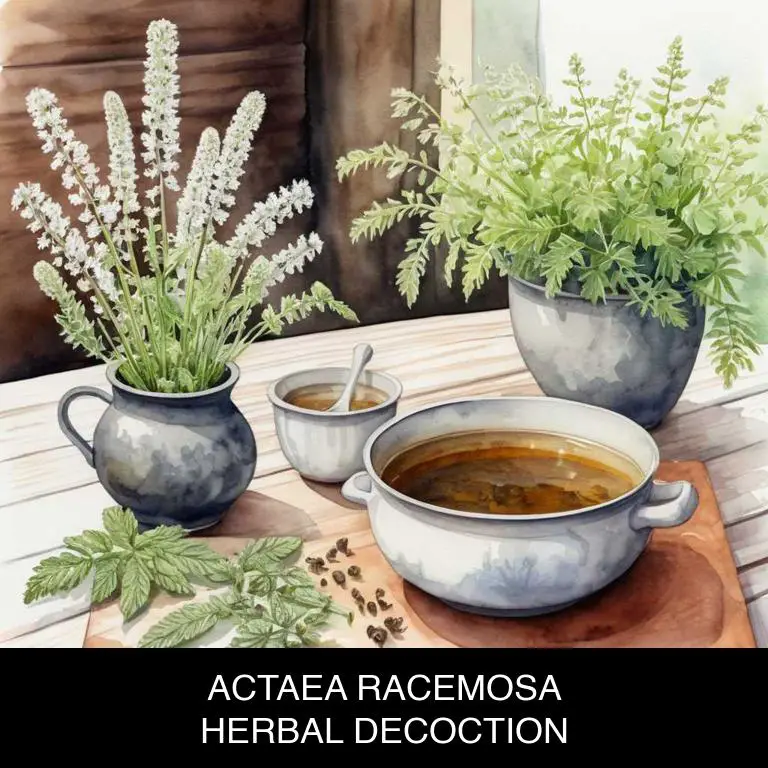
Medicinal Constituents
The list below shows the primary medicinal constituents in Actaea racemosa decoctions that help with endometriosis.
- Aromadendrene: This sesquiterpene has anti-inflammatory and antiproliferative properties, which may help reduce inflammation and slow down the growth of endometrial tissue.
- Actaea racemosa lignans: These lignans have estrogen-modulating effects, which may help alleviate the hormonal imbalances that contribute to endometriosis. By regulating estrogen levels, they may also reduce the growth and proliferation of endometrial cells.
- Berberine: This alkaloid has anti-inflammatory and antioxidant properties, which may help reduce inflammation and oxidative stress associated with endometriosis. It also has antimicrobial and anti-proliferative effects, which may help prevent bacterial infections and reduce the growth of endometrial tissue.
Parts Used
The list below shows the primary parts of black cohosh used to make decoctions for endometriosis.
- Roots: The roots are considered the most effective part for treating endometriosis due to their high concentration of actein and other bioactive compounds.
- Rhyzomes: The rhyzomes of Actaea racemosa contain similar bioactive compounds as the roots, making them a popular alternative for treating endometriosis.
- Seeds: The seeds are sometimes used in decoctions, although less commonly than roots or rhyzomes, due to their potential anti-inflammatory and antioxidant properties.
Quick Recipe
The following recipe gives a procedure to make a basic black cohosh for endometriosis.
- Harvest actaea racemosa roots in late summer or early fall when the plant is mature and the roots are fully developed.
- Chop the harvested roots into small pieces using a sharp knife or a root cutter with a diameter of about 1/8 inch.
- Combine the chopped actaea racemosa roots with 1 quart of water in a saucepan and bring the mixture to a boil.
- Reduce the heat to a simmer for 10 to 30 minutes or until the desired strength of the decoction is reached.
- Strain the decoction through a cheesecloth or a fine-mesh sieve into a clean container to remove the plant material.
10. Verbena hastata
Blue vervain decoctions helps with endometriosis because it has a potent anti-inflammatory effect that reduces uterine contractions, alleviating painful symptoms such as cramps and heavy bleeding.
The decoction's antioxidant properties also help to combat oxidative stress and inflammation in the pelvic area, which is often associated with endometriosis.
Additionally, blue vervain's ability to relax smooth muscle tissue can help to reduce spasms and discomfort, providing relief from symptoms that can significantly impact daily life.
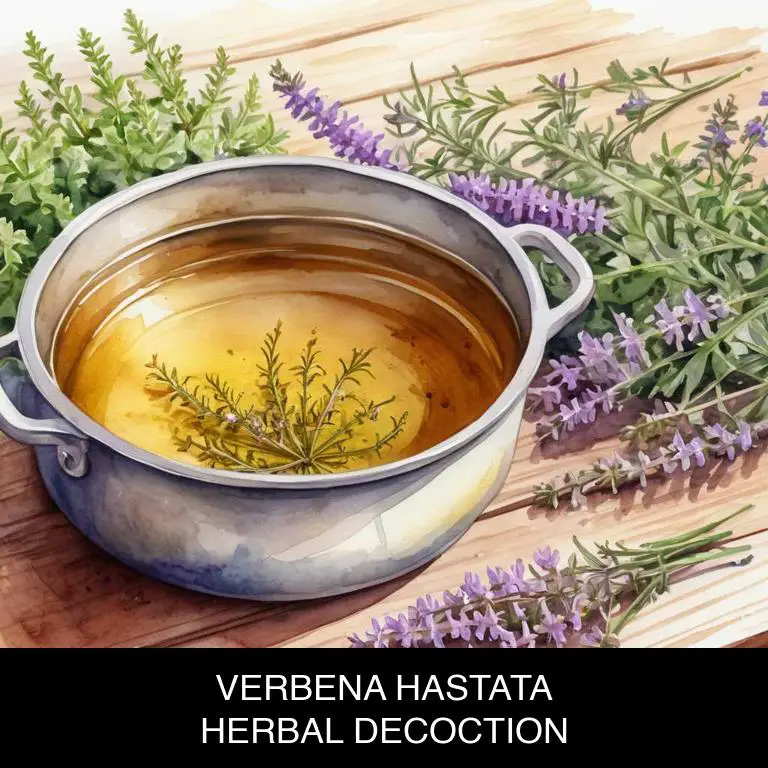
Medicinal Constituents
The list below shows the primary medicinal constituents in Verbena hastata decoctions that help with endometriosis.
- Flavonoids: These plant-based compounds have antioxidant and anti-inflammatory properties, which can help reduce inflammation and oxidative stress associated with endometriosis symptoms.
- Limonene: A terpene found in Verbena hastata, limonene has been shown to exhibit anti-inflammatory and hormone-regulating effects, which can help alleviate endometriosis symptoms such as pelvic pain and menstrual irregularities.
- Rosmarinic acid: A phenolic compound with antioxidant and anti-inflammatory properties, rosmarinic acid can help reduce inflammation and oxidative stress associated with endometriosis, as well as alleviate symptoms such as pain and cramping.
Parts Used
The list below shows the primary parts of blue vervain used to make decoctions for endometriosis.
- Roots: They are used due to their potential anti-inflammatory and antioxidant properties which may help alleviate endometriosis symptoms.
- Leaves: They are used due to their possible anti-inflammatory and estrogen-regulating properties which can help manage endometriosis.
- Flowers: They are used due to their potential estrogen-regulating and anti-inflammatory effects that may help reduce endometriosis symptoms.
Quick Recipe
The following recipe gives a procedure to make a basic blue vervain for endometriosis.
- Gently harvest fresh or dried verbena hastata flowers and leaves in the morning to ensure highest potency.
- Chop the harvested plant material into small pieces to increase surface area for efficient infusion.
- Combine 1 tablespoon of chopped verbena hastata with 1 cup of boiling water for 5 to 10 minutes steeping time.
- Strain the mixture through a cheesecloth or fine-mesh sieve to separate solids from liquid decoction.
- Store the herbal decoction in the refrigerator for up to 24 hours before consuming as a tea or using in recipes.
What is the best combination of herbal decoctions to use for endometriosis?
The best combination of herbal decoctions that help with endometriosis is a blend of Red Clover, Turmeric, Ginger, and Dandelion root.
Red Clover is rich in isoflavones, which help to alleviate symptoms of endometriosis by reducing inflammation and estrogen levels. Turmeric contains curcumin, a potent anti-inflammatory compound that eases pain and discomfort. Ginger soothes digestive issues, while Dandelion root supports liver function and reduces bloating.
Combining these decoctions may help to alleviate symptoms of endometriosis, promoting a more balanced and healthy menstrual cycle.
What ailments similar to endometriosis are treated with herbal decoctions?
Ailments similar to endometriosis/decoctions.html">endometriosis/decoctions.html">endometriosis that are treated with herbal decoctions are uterine fibroids, adenomyosis, and pelvic inflammatory disease.
Herbal remedies like turmeric, ginger, and raspberry leaf have anti-inflammatory properties that help alleviate symptoms such as pain, cramping, and heavy bleeding associated with these conditions.
Decoctions of dandelion root, goldenseal, and red clover may also be used to support uterine health and reduce inflammation.